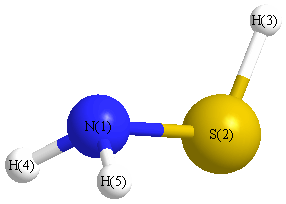Jump to
S1C2
Energy calculated at CCSD(T)/6-311G**
| | hartrees |
|---|
| Energy at 0K | -454.082460 |
| Energy at 298.15K | -454.086250 |
| HF Energy | -453.722231 |
| Nuclear repulsion energy | 57.396096 |
The energy at 298.15K was derived from the energy at 0K
and an integrated heat capacity that used the calculated vibrational frequencies.
Vibrational Frequencies calculated at CCSD(T)/6-311G**
| Mode Number |
Symmetry |
Frequency
(cm-1) |
Scaled Frequency
(cm-1) |
IR Intensities
(km mol-1) |
Raman Act
(Å4/u) |
Dep P |
Dep U |
|---|
| 1 |
A' |
3539 |
3414 |
|
|
|
|
| 2 |
A' |
2713 |
2618 |
|
|
|
|
| 3 |
A' |
1643 |
1585 |
|
|
|
|
| 4 |
A' |
1062 |
1024 |
|
|
|
|
| 5 |
A' |
919 |
886 |
|
|
|
|
| 6 |
A' |
669 |
645 |
|
|
|
|
| 7 |
A" |
3630 |
3502 |
|
|
|
|
| 8 |
A" |
1145 |
1104 |
|
|
|
|
| 9 |
A" |
451 |
436 |
|
|
|
|
Unscaled Zero Point Vibrational Energy (zpe) 7885.4 cm
-1
Scaled (by 0.9647) Zero Point Vibrational Energy (zpe) 7607.1 cm
-1
See section
III.C.1 List or set vibrational scaling factors
to change the scale factors used here.
See section
III.C.2
Calculate a vibrational scaling factor for a given set of molecules
to determine the least squares best scaling factor.
Geometric Data calculated at CCSD(T)/6-311G**
Point Group is Cs
Cartesians (Å)
| Atom |
x (Å) |
y (Å) |
z (Å) |
|---|
| N1 |
0.013 |
1.117 |
0.000 |
| S2 |
0.013 |
-0.622 |
0.000 |
| H3 |
-1.319 |
-0.772 |
0.000 |
| H4 |
0.505 |
1.453 |
0.821 |
| H5 |
0.505 |
1.453 |
-0.821 |
Atom - Atom Distances (Å)
| |
N1 |
S2 |
H3 |
H4 |
H5 |
| N1 | | 1.7387 | 2.3119 | 1.0139 | 1.0139 |
S2 | 1.7387 | | 1.3411 | 2.2851 | 2.2851 | H3 | 2.3119 | 1.3411 | | 2.9924 | 2.9924 | H4 | 1.0139 | 2.2851 | 2.9924 | | 1.6412 | H5 | 1.0139 | 2.2851 | 2.9924 | 1.6412 | |
 More geometry information
More geometry information
Calculated Bond Angles
| atom1 |
atom2 |
atom3 |
angle |
|
atom1 |
atom2 |
atom3 |
angle |
| N1 |
S2 |
H3 |
96.441 |
|
S2 |
N1 |
H4 |
109.389 |
| S2 |
N1 |
H5 |
109.389 |
|
H4 |
N1 |
H5 |
108.062 |
Electronic energy levels
Charges, Dipole, Quadrupole and Polarizability
Jump to
S1C1
Energy calculated at CCSD(T)/6-311G**
| | hartrees |
|---|
| Energy at 0K | -454.081550 |
| Energy at 298.15K | -454.085401 |
| HF Energy | -453.721954 |
| Nuclear repulsion energy | 57.659727 |
The energy at 298.15K was derived from the energy at 0K
and an integrated heat capacity that used the calculated vibrational frequencies.
Vibrational Frequencies calculated at CCSD(T)/6-311G**
| Mode Number |
Symmetry |
Frequency
(cm-1) |
Scaled Frequency
(cm-1) |
IR Intensities
(km mol-1) |
Raman Act
(Å4/u) |
Dep P |
Dep U |
|---|
| 1 |
A' |
3542 |
3417 |
|
|
|
|
| 2 |
A' |
2627 |
2534 |
|
|
|
|
| 3 |
A' |
1631 |
1574 |
|
|
|
|
| 4 |
A' |
1058 |
1021 |
|
|
|
|
| 5 |
A' |
892 |
861 |
|
|
|
|
| 6 |
A' |
657 |
634 |
|
|
|
|
| 7 |
A" |
3641 |
3512 |
|
|
|
|
| 8 |
A" |
1141 |
1100 |
|
|
|
|
| 9 |
A" |
550 |
531 |
|
|
|
|
Unscaled Zero Point Vibrational Energy (zpe) 7869.2 cm
-1
Scaled (by 0.9647) Zero Point Vibrational Energy (zpe) 7591.4 cm
-1
See section
III.C.1 List or set vibrational scaling factors
to change the scale factors used here.
See section
III.C.2
Calculate a vibrational scaling factor for a given set of molecules
to determine the least squares best scaling factor.
Geometric Data calculated at CCSD(T)/6-311G**
Point Group is Cs
Electronic energy levels
Charges, Dipole, Quadrupole and Polarizability
